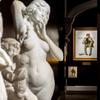The Painter of Joy and Light: Henri Lebasque
- July 09, 2021 07:51
Both friends and art critics alike dubbed him the "painter of joy and light." Post-Impressionist Henri Lebasque was an unabashed original, dedicating his life to bringing joy to his canvases. A generation younger than the great Impressionists Claude Monet and Pierre-Auguste Renoir, Lebasque nevertheless pursued many of their same painterly goals. Throughout his career, he sought to capture that ever-evasive sense of light and shadow, but in a world that was always bright and sunny. The pleasure of a family holiday, the contentment of a lounging nude, the vivid tranquility of the sea — these were the subjects of Lebasque, whose sensitivity and heart is felt in each and every brushstroke.
Lebasque was born in 1865 in Maine-et-Loire and moved to Paris in 1885, where he often visited the atelier of Léon Bonnat. It was an age when France had fully moved beyond the shadow of Napoléon’s reign into a new, industrial era; art likewise underwent an upheaval, as artists began to experiment beyond the traditions of the Academy. The Impressionists had already made waves with their new, modern approach to art, paving the way for Lebasque and his contemporaries.
He studied painting at the École des Beaux-Arts and fell under the influence of his fellow students Pierre Bonnard and Edouard Vuillard. They were both key members of Les Nabis, a group of young French artists whose Symbolist approach to art proved a key link in the transition from Impressionism to abstraction. Thus, much of Lebasque’s earliest works are more somber than the bright and colorful for which he would eventually be renowned.
A key turning point in his career came in 1903 when Lebasque became a founding member of the Salon d’Automne along with Henri Matisse and other artistic revolutionaries. Established as a reaction against the official Salon, the Salon d’Automne exhibited the most groundbreaking new styles of its day; its inaugural show in 1903 included works by Lebasue, Matisse, Pierre Bonnard, Henri Manguin, Armand Guillaumin and many others, while also including an homage to Paul Gauguin, who had died that same year.
Perhaps the most important show in the organization’s history was held in 1905; this exhibition featured the boldly colored and highly controversial paintings of Matisse, Derain, Vlaminck, Manguin, Vuillard and Rouault. The critic Louis Vauxcelles dubbed the group Les Fauves, or "wild beasts," due to their use of bright colors and wild, untamed lines. His inclusion in the organization provided Lebasque with a new, highly modern aesthetic with which he would experiment and eventually assimilate.
Just one year later, in 1906, Lebasque embarked on the first of many visits to the French Riviera at the suggestion of his friend and fellow Fauvist, Henri Manguin. He was so enamored with the brilliant color and light of the region that he would frequently return, spending many summers there with his family, particularly in the town of Sainte-Maxime. Since his very first visit to the French Riviera, Lebasque's brightened canvases earned him the moniker the "painter of joy and light."
During his mature years, the focus of his art became his family, particularly his wife and daughters on holiday. The vibrancy of his palette echoed the sense of escapism he found in the Mediterranean, and his canvases likewise display his carefree approach to life. His style took on a high degree of flexibility, and he readily incorporated different elements of Neo-Impressionism, Fauvism, Pointillism and other modern movements into his compositions from this period. By the 1920s, the artist gradually moved towards a more simple and pure stylistic approach, wherein he painted in large swathes of flattened color. Yet, his works were always harmonious and always displayed the bold use of color that he maintained throughout his career.
After devoting his whole life to his family and his painting, Lebasque died at Le Cannet, Alpes-Maritimes on August 7, 1937. A major retrospective of his work was organized by the Musée des Ponchettes in Nice 20 years later in 1957, shedding light on his remarkable achievements and lasting legacy. Today, his paintings can be found in important museums around the world, including the Musée d'Orsay (Paris), the Museum of Fine Arts (St. Petersburg), the Museo Nacional Thyssen-Bornemisza (Madrid), the National Museum of Western Art (Japan), the Harvard University Art Museum and the Indianapolis Museum of Art.
M.S. Rau is proud to offer a number of works by this important artist. Click here to view our current collection.
About M.S. Rau:
M.S. Rau has spent more than 100 years earning the trust of discerning collectors worldwide. Located in the heart of New Orleans’ historic French Quarter, our peerless showroom houses one of the world’s most extensive and stunning collections of museum-quality fine art by artists such as Claude Monet and William Bouguereau, 18th- and 19th-century antiques and breathtaking jewelry, including rare colored diamonds.






100x100_n.jpg)
100x100_c.jpg)













100x100_c.jpg)